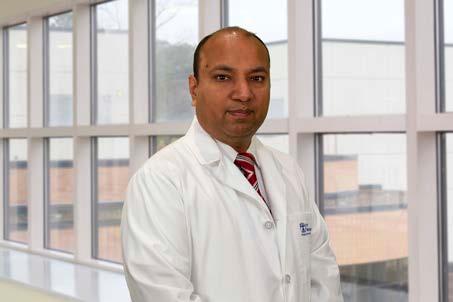Gò0dNews from the Physician’s Desk
What is COPD?
C
by Vikas Jain, MD of Hamilton Physician Group-Specialty Care
OPD affects over 30 million people in the U.S. Correct diagnosis and education are the key to appropriate and adequate treatment. COPD develops slowly and can worsen over time. When COPD is severe, symptoms can get in the way of the most basic tasks, such as doing light housework, taking a walk, even bathing and getting dressed. Many people with COPD avoid activities that they used to enjoy because they have difficulty breathing. What is COPD Chronic Obstructive Pulmonary Disease (COPD) is a term used to describe chronic lung diseases including emphysema and chronic bronchitis. This disease is characterized by shortness of breath. COPD is currently an incurable disease, but with the right diagnosis and treatment, there are many things you can do to breathe better and enjoy life. Chronic: “Chronic” means that the disease lasts a long time and is always present. While the symptoms may take years to develop and the severity may differ at times, there is still much you can do to slow the progress of the disease. Obstructive: The ability to move air in and out of the lungs is blocked or obstructed. This is caused by swelling and extra mucus in the tubes of the lungs which carry air in and out. Pulmonary: This means that the disease is located in the lungs. Disease: The lungs have some damage. But even though a cure hasn’t been found yet, the symptoms can be treated. Signs and Symptoms of COPD It’s easy to think of shortness of breath and coughing as a normal part of aging, but these could be signs of COPD. COPD can progress for years without noticeable shortness of breath. That’s why it is important to talk with your healthcare provider as soon as you notice these symptoms. Everyone at risk for COPD who has cough, breathlessness, or sputum production, should have a pulmonary lung function test (spirometry). Ask your healthcare provider about ordering this test. Spirometry measures the amount of air a person can blow out of the lungs (volume) and how fast they can blow it out (flow). Symptoms of COPD can be different for each person, but the common symptoms are: • Increased shortness of breath • Frequent coughing (with and without mucus) • Wheezing • Tightness in the chest Not all COPD is the same There are different types of COPD. Each type may affect how well different treatments work, how symptoms affect everyday life, and how they progress. If you have another health condition in addition to COPD, such as high blood pressure, heart disease,
44 // November 2020
heartburn, depression, or diabetes, this can also affect COPD and how it is managed. Here are some things that can help determine the particular type of COPD. Taking these things into consideration can be useful in addition to spirometry numbers and other factors. 1. Do you have a cough? If so, do you cough up mucus on most days for at least three months in a period of at least two years? If yes, you may have a chronic bronchitis type of COPD that will respond to different medicines. 2. Have you been told that your lungs are stretched out and bigger than normal? If so, are they stretched out throughout your whole lung or just in certain places? If so, this is emphysema which is diagnosed by a radiology test. Sometimes it is possible to decrease the size of the big, stretched out places in the lungs. Who is at Risk? Smoking cigarettes is the principal risk factor for COPD in the U.S. There are other risk factors, including pollutants such as fumes or chemicals, dust, and smoke (including secondhand smoke). In some cases, COPD is caused by a genetic condition called alpha-1antitrypsin deficiency. COPD most often occurs in people over age 40, but can develop earlier in individuals with alpha-1-antitrypsin deficiency. COPD diagnosis requires, at a minimum, a medical history, physical exam, and low flow rates on spirometry. What do I do if I have COPD? 1. Quit smoking. It is never too late to quit smoking. 2. Avoid exposure to pollutants (fumes, chemicals, dust, and smoke). 3. Visit your healthcare provider or pulmonologist on a regular basis, even when you are not sick. Many medications used for COPD are delivered by inhalers, so ask your healthcare provider to show you how to use inhalers correctly and then check your inhaler technique. Be sure to tell your doctor about all your health conditions and bring all your medicines to your visit. 4. Take precautions against seasonal flu. This includes getting a flu vaccine each year.
















